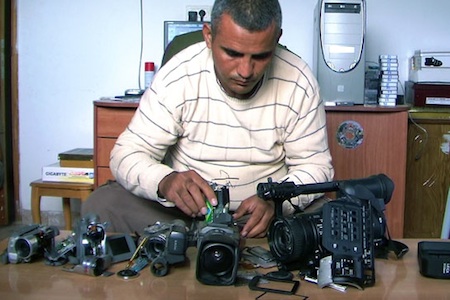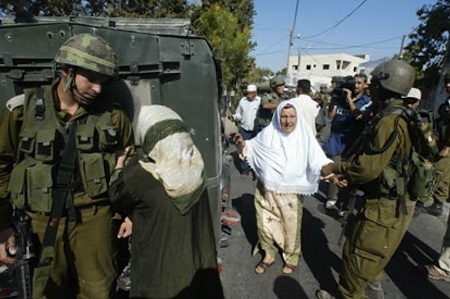The nomination of 5 Broken Cameras for this year’s Best Documentary Oscar is a sign of the times. Like the now de rigueur marquee-category nominations for independently funded festival pickups, and the very new normal of nominations for shorts funded via Kickstarter, it shows how mainstream film culture is increasingly shaped by contributions far away from any industrial center. Including, in this case, an amateur Palestinian videographer, Emad Burnat, from the West Bank village of Bil’in, who began shooting his town’s protests against encroaching Israeli settlements in 2005; and a more experienced Israeli activist filmmaker, codirector Guy Davidi, who joined the project in 2009, helping Burnat to shape his previous footage and to shoot with an eye towards a feature.
This also suggests another fundamental change, one shaping the contemporary documentary format: as bearing witness becomes an act simultaneous to any social act or political action, current events are represented through a multiplicity of sources, so that the voices we here are increasingly those of participants rather than “gatekeepers” (to borrow the title of this year’s other Oscar-nominated documentary treatment of the Palestinian Question).
Burnat began filming home movies, he says, beginning with the birth of his fourth son in 2005—concurrent with the construction of new Israeli settlements opposite his hometown. The personal is political—Burnat can also tie one son’s birth to the Oslo Accords, and another’s to the 2000 Intifada—and as a local man with a movie camera, he becomes the quasi-official videographer for protests against a security fence which effectively extends the Israeli settlement even further into Palestinian territory, putting a manned barrier between Bil’in and the olive trees its residents have long harvested. Though the voiceover is in present tense throughout, the film as we see it begins to take shape midway through the protests (which tie into the last decade’s larger story of unrest), when Burnat screens his raw footage to galvanize the community.
The five broken cameras of the title are Burnat’s, each one of which came to a violent end (one in an automobile accident, the other four in the line of duty). But they’re not really a structuring device in the formal sense: only about eighty percent of the footage in the finished film, Davidi has said, came from Burnat’s successive cameras. (This jibes with many of the cuts during the protest footage; and with the scene in which Burnat films himself receiving Camera #2.) This is perfectly appropriate: as Israeli soldiers arrest and hustle away Palestinian protestors, also see other villagers racing alongside, holding up cameraphones and other devices to keep a record. The palpable sense of physical agitation conveyed by the film comes from this jostling for representation, as much as from conflict.
It’s in this sense, then, that the five broken cameras structure the film: as an overarching metaphor. In multiple, extraordinary scenes, they take bullets for Burnat. There’s also a chilling moment when Israeli settlers approach Burnat as he films, hands over their faces. “What’s up, man?” one of them says. It’s the last we see from Camera #2. And Burnat is ordered to shut off Camera #3 when soldiers arrive at his front door after dark, telling him his own house is now a Closed Military Zone. The film documents unjust power’s obvious disincentive towards, and visceral discomfort with, transparency.
“The World Is Watching,” is a battle cry for civil disobedience everywhere, and as Burnat and his fellow-activists occupy land on the settlement side of the fence, in trailers and then in ad-hoc concrete structures, much of the footage elicits outrage similar to other recent video dispatches from other resistance movements. The militarization of crowd control, and the procedural endorsement of tetchy peace officers’ resentment of nonviolent obstructions, abroad as at home, comes through clearly through a rain of tear-gas grenades, arcing over the scattering activists.
This sort of evidence is all to say that the film’s title withholds a note of defiance: even aside from the sixth, intact camera with which Burnat films the framing sequence, including the hopeful family postcard which closes the film, there is the survival of the footage itself, even as it shudders from impact. The film is about the struggle to see clearly, and the preciousness of that clarity—it’s about how this struggle is increasingly inextricable from the struggle for social justice itself.
But one comes to realize this, it must be said, in large part through frustrations with the film itself. So many shots of Israeli soldiers firing into dispersing crowds follow hard, discontinuous edits, so that context is frustratingly elusive. This is bad not because context would necessarily change how sympathetically we’re disposed to Burnat’s cause—what sort of explanatory context would justify an Israeli soldier taking careful aim at the kneecap of a bound Palestinian prisoner, and letting fly at point-blank range?—but because it leaves one feeling helpless to understand the violence in even a basic spatial sense, and guarded rather than righteous in our outrage. The voiceover with which Burnat narrates the action is no more detailed than the explanations we see him giving his toddler son. (In fact, Davidi seems to have written much of Burnat’s voiceover, which may explain the insistence with which the resistance is humanized through the childlike innocence of one of Burnat’s friends.)
Whether the film’s strategy is motivated by political expediency, or fog-of-war-style impressionism or is simply a way to smooth over the difficulties an inexperienced cameraman had in getting clear shots of sudden violence, it’s very much to the film’s point, which is the friction and human heat and anxiety one feels when shouldering oneself into the best angle from which to see.
So maybe another way in which 5 Broken Cameras signals a change in the documentary is in the demands it makes on viewers, More information, after all, is only better if we’re commensurately more sophisticated at processing it. The onus is on us, as viewers, to balance perspective and storytelling strategies, to be at once open and skeptical, receptive and practiced—to be the gatekeepers to our own minds.





